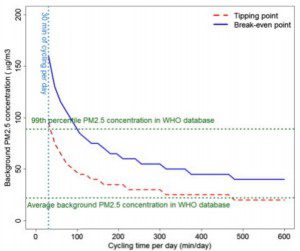Cycling’s health benefits greater than risk posed by dirty air (to a point)
A Cambridge University study has concluded that the benefits of cycling outweigh the negative health impact of active travel in polluted cities, at least until you’ve cycled 90 minutes in 100 μg/m3 or more.
Having just last month published a paper detailing how 85% of a region’s cycling increase can be attributed directly to cycling infrastructure, the researchers have now published in the Journal of Preventive Medicine a study that concludes that, while dirty air will indeed reduce the advantages of active travel, in most urban environments the health benefit gained outweighs the negative effects.
In what has become an election issue worldwide, poor air in the UK is said to cost around 40,000 their lives prematurely and will cause further issues as summer rolls around. In the USA, more than half of the population lives amid dangerous pollution, according to the American Lung Association.
Funded by the Medical Research Council and carried out in between the Centre for Diet and Activity Research and the University’s Medical Research Council Epidemiology Unit, the open access study compared the effects on all-cause mortality of pollution levels against active travel. Studying the concentration of fine particulates in circulation, the authors of the paper analysed data from prior studies to conclude how dangerous certain level of pollution would be to those moving outside of cars.
Even in the most polluted city – Delhi at 153μg/m3 – both walking and cycling’s benefits trump the negative effects of dirty air.
Levels of pollution that are deemed safe vary from country to country, but in Europe the Common Air Quality Index places 0/25 as very low, 25/50 as low, 50/75 in amber, indicating a warning, High at 75/100 and very high at 100>. These measures are based on analysis of three pollutants PM10, NO2 and O3, though do take into account finer particulate matter including CO, PM2.5 and SO2. 
The University’s study concludes that with a global average urban background of PM2.5 concentration sat at (22 μg/m3), even extreme levels of active travel and exercise will remain positive.
In regions where pollution sits at 100 μg/m3, harm exceeds benefit after 90 minutes of cycling, or 10 hours of walking.
In its conclusion, the paper says active travel should be encouraged, despite the creeping threat of pollutants.
The authors suggest: “Our calculations show that promoting cycling and walking is justified in the vast majority of settings, and only in a small number of cities with the highest PM2.5 concentration in the world cycling could lead to increase in risk.”
The World Health Organisation recently reached the same conclusions, encouraging cities around the globe to build in active travel in a bid to decrease obesity and inactivity related diseases.
Read the full paper here.



